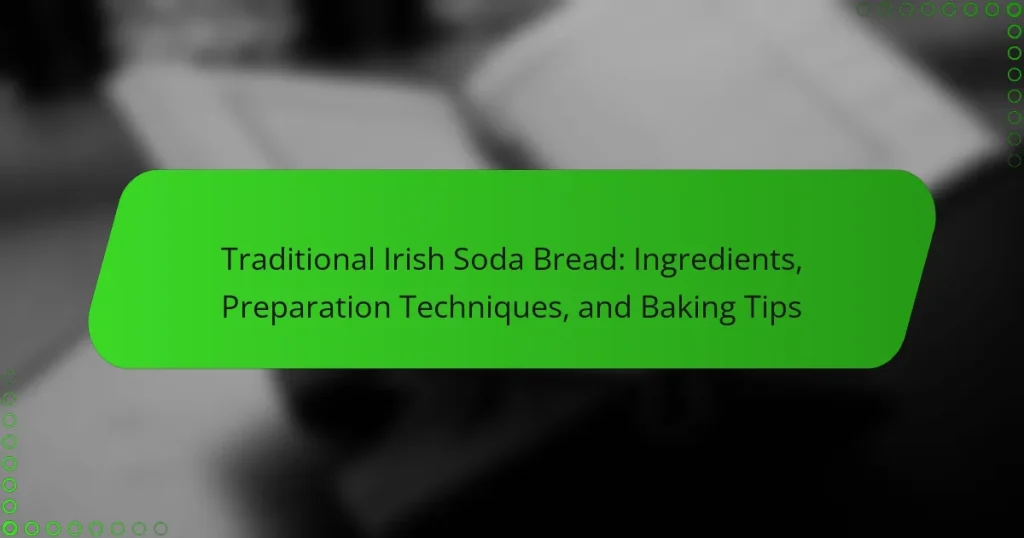Traditional Irish soda bread is a quick bread made with baking soda as a leavening agent, distinguished by its simple ingredients: flour, baking soda, salt, and buttermilk. This bread, known for its dense texture and slightly tangy flavor, originated in 19th century Ireland and is traditionally shaped into a round loaf with a scored cross on top for even cooking. The article covers essential baking techniques, including ingredient selection, mixing methods, and baking tips to achieve an authentic texture and taste. Additionally, it provides guidance on serving suggestions and storage methods to maintain freshness.

What is Traditional Irish Soda Bread?
Traditional Irish soda bread is a type of quick bread made using baking soda as a leavening agent. It typically consists of simple ingredients such as flour, baking soda, salt, and buttermilk. The absence of yeast distinguishes it from other bread types. This bread has a dense texture and a slightly tangy flavor due to the buttermilk. Traditionally, it is shaped into a round loaf and often scored with a cross on top. This scoring helps the bread cook evenly and is a customary practice in Irish baking. Historical records suggest that soda bread originated in Ireland during the 19th century. It became popular due to the availability of baking soda and buttermilk, which were common in Irish households.
How is Traditional Irish Soda Bread different from other types of bread?
Traditional Irish Soda Bread differs from other types of bread primarily due to its leavening agent. It uses baking soda instead of yeast, which results in a quicker preparation time. The dough is typically made with a simple mixture of flour, buttermilk, and salt. This combination creates a dense, hearty texture that is unique to soda bread.
Unlike yeast-leavened breads, soda bread does not require rising time. The chemical reaction between baking soda and buttermilk produces carbon dioxide, which helps the bread to rise. Traditional Irish Soda Bread often has a slightly tangy flavor from the buttermilk.
Additionally, it is commonly baked in a round shape and scored with a cross on top. This scoring helps the bread to cook evenly. The bread is also typically enjoyed fresh and is best served warm.
What are the historical origins of Traditional Irish Soda Bread?
Traditional Irish Soda Bread originated in Ireland during the 19th century. It was developed as a quick and easy bread-making method. The introduction of baking soda as a leavening agent revolutionized bread preparation. This method was particularly useful for the poor, who lacked access to yeast and ovens. The use of buttermilk in the recipe also contributed to its unique flavor and texture. Traditional recipes often included wholemeal flour, making it a nutritious option. Soda bread became a staple in Irish households, reflecting the simplicity and resourcefulness of Irish cooking. Its historical significance is tied to the cultural identity of Ireland.
What are the key characteristics of Traditional Irish Soda Bread?
Traditional Irish Soda Bread is characterized by its use of baking soda as a leavening agent instead of yeast. This method creates a dense, hearty texture. The bread typically includes simple ingredients such as flour, buttermilk, salt, and baking soda. It is known for its quick preparation time, requiring no lengthy rising periods. Traditional Irish Soda Bread often features a distinctive cross cut on top, which helps it cook evenly. This bread has a slightly tangy flavor due to the buttermilk. Historically, it was a staple in Irish households, reflecting the availability of local ingredients. The bread is best enjoyed fresh, often served with butter or jam.
What are the main ingredients used in Traditional Irish Soda Bread?
The main ingredients used in Traditional Irish Soda Bread are flour, baking soda, salt, and buttermilk. Flour serves as the primary base for the bread. Baking soda acts as the leavening agent, allowing the bread to rise. Salt enhances the flavor of the bread. Buttermilk provides moisture and acidity, which reacts with baking soda to create a light texture. These ingredients combine to create a simple yet flavorful bread that is a staple in Irish cuisine.
How does each ingredient contribute to the texture and flavor?
Flour provides the structure and base flavor of traditional Irish soda bread. The protein content in flour influences the bread’s density and chewiness. Baking soda acts as a leavening agent, creating a light and airy texture. It also adds a slight tang to the flavor profile. Buttermilk contributes moisture and acidity, enhancing the bread’s tenderness. The acidity from buttermilk activates baking soda, further aiding in leavening. Salt enhances flavor and controls yeast fermentation during baking. Lastly, any added ingredients such as caraway seeds or raisins provide unique flavor notes and texture variations.
What are common variations of ingredients in Traditional Irish Soda Bread?
Common variations of ingredients in Traditional Irish Soda Bread include buttermilk, baking soda, flour, and salt. Some recipes incorporate whole wheat flour for added texture and flavor. Others may use oats or rye flour as alternatives. Raisins or currants are often added for sweetness. Caraway seeds can provide a distinctive flavor. Some variations include seeds or nuts for crunch. Additionally, herbs like rosemary or thyme may be introduced for a savory twist. Each variation maintains the basic soda bread structure while offering unique tastes and textures.
How do you prepare Traditional Irish Soda Bread?
To prepare Traditional Irish Soda Bread, start by gathering the necessary ingredients. You will need 4 cups of all-purpose flour, 1 teaspoon of baking soda, 1 teaspoon of salt, and 1.5 cups of buttermilk. Preheat your oven to 425°F (220°C). In a large bowl, mix the flour, baking soda, and salt together. Make a well in the center of the dry ingredients and pour in the buttermilk. Stir until a dough forms. Turn the dough onto a floured surface and knead gently for about 1 minute. Shape the dough into a round loaf. Place the loaf on a baking sheet lined with parchment paper. Cut a deep cross on top of the loaf to allow for even baking. Bake for 30 minutes or until the bread is golden brown and sounds hollow when tapped on the bottom. Let it cool on a wire rack before slicing.
What are the essential steps in the preparation process?
The essential steps in the preparation process for traditional Irish soda bread include gathering ingredients, mixing dry components, adding wet ingredients, kneading the dough, shaping the loaf, and scoring the top. First, gather all necessary ingredients: flour, baking soda, salt, and buttermilk. Next, mix the flour, baking soda, and salt in a large bowl until well combined. Then, create a well in the center and pour in the buttermilk. Stir until a soft dough forms. After that, knead the dough gently on a floured surface for about one minute. Shape the dough into a round loaf and place it on a baking sheet. Finally, score a deep cross on the top of the loaf to allow for even baking. These steps ensure the proper texture and flavor characteristic of traditional Irish soda bread.
How do you mix and knead the dough effectively?
To mix and knead the dough effectively, combine the dry ingredients first. Use a large bowl to mix flour, baking soda, and salt thoroughly. Create a well in the center to add the wet ingredients. Gradually pour in buttermilk while stirring with a wooden spoon. Mix until the dough starts to come together.
Once combined, transfer the dough to a floured surface. Knead the dough gently for about 5-10 minutes. Fold the dough over itself and push down with the heel of your hand. This process develops gluten, giving the bread structure. Avoid over-kneading, as it can result in a tough texture.
Effective mixing and kneading lead to a light, airy bread. This method is essential for achieving the desired consistency in traditional Irish soda bread.

What are the best baking techniques for Traditional Irish Soda Bread?
The best baking techniques for Traditional Irish Soda Bread include using the right ingredients and proper mixing methods. Start with fresh baking soda for optimal leavening. Combine the dry ingredients thoroughly before adding wet ingredients. Use buttermilk for a tender texture and authentic flavor. Mix the dough gently to avoid overworking it. Shape the dough into a round loaf without excessive kneading. Score the top with a cross to allow for even rising. Bake in a preheated oven at a high temperature for a crispy crust. These techniques ensure a traditional texture and taste, as evidenced by historical recipes passed down through generations.
How do you properly bake Traditional Irish Soda Bread?
To properly bake Traditional Irish Soda Bread, start by preheating your oven to 425°F (220°C). In a large mixing bowl, combine 4 cups of all-purpose flour, 1 teaspoon of baking soda, and 1 teaspoon of salt. Mix the dry ingredients thoroughly to ensure even distribution. Create a well in the center of the mixture and pour in 1 ¾ cups of buttermilk. Stir gently until the dough begins to come together.
Once the dough forms, transfer it to a floured surface and knead lightly for about 30 seconds. Shape the dough into a round loaf, approximately 1.5 inches thick. Place the loaf on a baking sheet lined with parchment paper. Score a deep cross on the top of the loaf using a sharp knife. This allows the bread to expand while baking.
Bake in the preheated oven for 30-35 minutes. The bread is done when it sounds hollow when tapped on the bottom. Allow the bread to cool on a wire rack before slicing. Traditional Irish Soda Bread is best enjoyed fresh, often served with butter or jam.
What temperature and time are ideal for baking?
The ideal temperature for baking traditional Irish soda bread is 425°F (220°C). The recommended baking time is approximately 30 to 40 minutes. This temperature ensures that the bread rises properly and develops a nice crust. Baking at this heat allows for even cooking throughout the loaf. Checking for doneness can be done by tapping the bottom of the bread; it should sound hollow when fully baked. This method is consistent with traditional baking practices for soda bread.
How can you tell when the bread is done baking?
Bread is done baking when it has a golden-brown crust and sounds hollow when tapped. The internal temperature of the bread should reach about 190°F to 210°F. Additionally, the bread should have risen well and feel firm to the touch. These indicators ensure the bread is fully cooked through. A toothpick inserted into the center should come out clean or with a few crumbs. These methods are commonly used by bakers to determine doneness.
What tips can improve the baking of Traditional Irish Soda Bread?
To improve the baking of Traditional Irish Soda Bread, use fresh baking soda. Fresh baking soda ensures proper leavening, leading to a lighter texture. Measure ingredients accurately, especially flour and buttermilk. Accurate measurements contribute to the right dough consistency. Mix the dough gently to avoid overworking it. Overworking can result in a dense bread. Shape the loaf with a light hand to maintain air pockets. Air pockets create a fluffy interior. Score the top of the dough before baking. Scoring allows for better expansion during baking. Bake in a preheated oven at the correct temperature, typically 425°F (220°C). The right temperature promotes even cooking and browning. Finally, allow the bread to cool on a wire rack after baking. Cooling prevents moisture buildup, maintaining crust quality.
How can you achieve a perfect crust on Traditional Irish Soda Bread?
To achieve a perfect crust on Traditional Irish Soda Bread, use a hot baking surface. Preheat your oven to 450°F (232°C) and place a baking stone or cast-iron skillet inside. This method helps create steam during baking. Steam is essential for crust development. Additionally, scoring the top of the dough allows for better expansion. Use a sharp knife to make a deep cross or slash before baking. Finally, bake until the crust is golden brown and the bread sounds hollow when tapped. This indicates a well-cooked crust.
What common mistakes should be avoided when baking?
Common mistakes to avoid when baking include not measuring ingredients accurately. Accurate measurements ensure the right chemical reactions occur during baking. Another mistake is not preheating the oven. Preheating allows the dough to rise properly. Overmixing the batter can lead to tough bread. Gentle mixing keeps the texture light and airy. Ignoring the recipe’s instructions may result in uneven baking. Following the recipe ensures consistency and quality. Lastly, opening the oven door frequently can cause temperature fluctuations. Maintaining a stable temperature is crucial for proper baking.

How can you serve and store Traditional Irish Soda Bread?
Serve Traditional Irish Soda Bread sliced, ideally with butter or jam. It pairs well with soups and stews. For storage, wrap the bread in a clean kitchen towel. Place it in an airtight container or a plastic bag. This method keeps the bread fresh for up to 2 days at room temperature. For longer storage, freeze the bread. Wrap it tightly in plastic wrap and then in aluminum foil. Frozen soda bread maintains quality for up to 3 months.
What are the best ways to serve Traditional Irish Soda Bread?
Traditional Irish Soda Bread is best served warm with butter. Slicing the bread while it’s still warm enhances its flavor and texture. It pairs well with soups and stews, providing a hearty accompaniment. Additionally, it can be served with jams or honey for a sweet option. For breakfast, it complements a traditional Irish breakfast alongside eggs and bacon. Serving it with cheese also creates a delightful combination. These serving methods highlight the bread’s versatility and enhance the dining experience.
What toppings or accompaniments pair well with Traditional Irish Soda Bread?
Traditional Irish Soda Bread pairs well with butter, jam, and cheese. Butter enhances the bread’s flavor and moistness. Jam, particularly fruit varieties like raspberry or strawberry, adds sweetness. Cheese, such as Irish cheddar, complements the bread’s texture and taste. These toppings are commonly enjoyed in Ireland. They provide a balance of flavors that enhance the overall experience of consuming soda bread.
How do you store Traditional Irish Soda Bread for freshness?
Store Traditional Irish Soda Bread in an airtight container to maintain freshness. This prevents exposure to air, which can cause the bread to dry out. Alternatively, wrap the bread tightly in plastic wrap or aluminum foil. Keep it at room temperature for up to two days. For longer storage, place the bread in the refrigerator or freeze it. If freezing, slice the bread before wrapping for easy access. Thaw frozen slices at room temperature or toast them directly from the freezer. Proper storage methods can significantly extend the bread’s shelf life.
What are the best practices for freezing Traditional Irish Soda Bread?
To freeze Traditional Irish Soda Bread effectively, first ensure it has completely cooled. Wrap the bread tightly in plastic wrap to prevent freezer burn. Then, place the wrapped bread in a resealable freezer bag for added protection. Label the bag with the date to track freshness. For best results, slice the bread before freezing, allowing for easier portioning later. Traditional Irish Soda Bread can maintain quality for up to three months in the freezer. When ready to use, thaw the bread at room temperature or toast slices directly from frozen.
What are some troubleshooting tips for baking Traditional Irish Soda Bread?
To troubleshoot baking Traditional Irish Soda Bread, ensure accurate measurements of ingredients. Use a kitchen scale for precise flour and baking soda quantities. If the bread is too dense, check the freshness of your baking soda. Old baking soda may not provide adequate leavening. For a dry texture, add more buttermilk gradually until the dough is soft. If the bread doesn’t rise, ensure the oven is preheated to the correct temperature, typically around 425°F (220°C). For uneven baking, rotate the bread halfway through the baking time. If the crust is too hard, cover the bread with a clean kitchen towel after removing it from the oven.
Traditional Irish Soda Bread is a quick bread made with baking soda, flour, salt, and buttermilk, distinguished by its dense texture and tangy flavor. This article covers the key ingredients, preparation techniques, and baking tips essential for creating authentic soda bread. It explores the historical origins of the bread, variations in ingredients, and the best practices for serving and storing it. Additionally, troubleshooting tips are provided for common baking issues, ensuring a successful outcome for home bakers.


